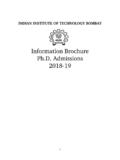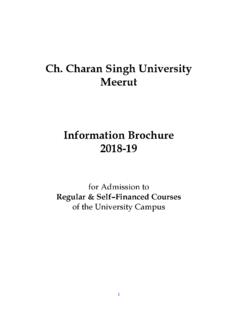Transcription of Green synthesis of silver nanoparticles from seed …
1 IOSR Journal of Pharmacy and Biological Sciences (IOSR-JPBS) e-ISSN: 2278-3008, p-ISSN:2319-7676. Volume 10, Issue 4 Ver. I (Jul - Aug. 2015), PP 76-90 DOI: 76 | Page Green synthesis of silver nanoparticles from seed extracts of Cyperus esculentus and Butyrospermum paradoxum Ibironke A. Ajayi, Adewale A. Raji and Emmanuel O. Ogunkunle Objective: To synthesize silver nanoparticles from two medicinally important plant seed extracts of Cyperus esculentus and Butyrospermum paradoxum for the first time and to check the potency of the crude methanolic extracts and their synthesized nanoparticles on ten different human pathogens.
2 The percentage yields of two seed extracts were and respectively and subjected to phytochemical and antimicrobial screenings. For the synthesis of silver nanoparticles (AgNPs), different aqueous concentrations (1mM and 3mM) of silver nitrate solutions were prepared and added to the methanolic extracts of the two plants seeds under mild reaction conditions. synthesis of AgNPs was confirmed from the change of colour of the reaction mixtures, change in pH, FTIR spectrum and UV-Vis study of the colloidal solutions and further subjected to antimicrobial screening.
3 Methods: Characterization of nanoparticles was done by using UV-visible spectroscopy, FTIR and pH meter to monitor and characteristics the nanoparticles . Result: The phytochemical screening of the extracts revealed the presence of alkaloids, carbohydrate, cardiac glycosides, flavonoids, phenols, saponins, sterols, tannin, terpenoids and reducing sugar in the two samples. However, phlobatannins and quinone were absent in B. paradoxum seed extract. The presence of phenols, terpenoids and flavonoids showed that the seed extracts were viable for the synthesis of nanoparticles .
4 Antimicrobial activities revealed t thepotency of seed extract as compared to C. esculentus seed extract while the antimicrobial activities of the synthesized nanoparticles also revealed that the 3mM silver nanoparticles were more potent in inhibiting the growth of microorganisms than the seed extracts. This is an indication that silver nanoparticles could be used as antibacterial agents. Conclusions: It can be concluded that the seeds of C. esculentus and B. paradoxum could be a good source for t h e synthesis o f s i l v e r nanoparticles which shown h i g h antimicrobial a c t i v i t y against ten different human pathogens.
5 The important outcome of this s t u d y will be of high value products from medicinal plants C. s esculentus and for biomedical and nanotechnology based industries. Keywords: C. esculentus, B. paradoxum, phytochemical, antimicrobial, nanoparticles . I. Introduction The development of Green processes for the synthesis of nanoparticles is evolving into an important branch of nanotechnology [1, 2]. The research on synthesized nonmaterial and their characterization is an emerging field of nanotechnology from the past two decades, due to their huge applications in the fields of physics, chemistry, biology and medicine [3].
6 In recent years, noble metal nanoparticles have been the subject of focused research due to their unique optical, electronic, mechanical, magnetic, and chemical properties that are significantly different from those of bulk materials [3]. Nanotechnology is a field that is mushrooming, making an impact in all spheres of human life. A number of approaches are available for the synthesis of silver nanoparticles viz, reduction in solutions, chemical and photochemical reactions in reverse micelles, thermal decomposition of silver compounds, radiation assisted, electrochemical, microwave assisted process and recently via Green chemistry route [4] The biosynthetic method employing plant extracts [5] has received much attention recently owing to its simplicity, eco-friendliness and economically viable nature, compared to the other existing methods such as using bacteria and fungi [6]
7 And the chemical [7, 8] and physical methods used for synthesis of metal nanoparticles . Understanding the biochemical processes that lead to the formation of nanoscale inorganic material is potentially appealing as an environment-friendly alternative to chemical methods [9]. Nanoscale materials have emerged as novel antimicrobial agents owing to their high surface area to volume ratio and the unique chemical and physical properties, which increases their contact with microbes and their ability to permeate cells [10]. Also, nanotechnology has amplified the effectiveness of silver particles as antimicrobial agents Many reports are available on the biogenesis of silver nanoparticles using several plant extracts, particularly neem leaf broth (Azadirachta indica), Pelargonium graveolens, geranium leaves, Medicago sativa (Alfalfa), Aloe vera, Emblica officinalis (Amla, Indian Gooseberry) and few microorganisms.
8 C. esculentus, also known as yellow nut sedge or earth almond, is a minor crop grown in temperate Green synthesis Of silver nanoparticles From Seed Extracts Of Cyperus Esculentus .. DOI: 77 | Page and tropical zones of the world. In tile temperate zone, it is grown in Spain, Italy, and the United States. In the tropics, it is found largely in India and West Africa. It is an annual or perennial plant, growing to 90 cm tall, with solitary stems growing from a tuber. The plant is reproduced by seeds, creeping rhizomes and tubers while B.
9 Paradoxum (Shea butter) is a medium-sized deciduous tree belonging to the family Sapotaceae. It is believed that it is native to the West-African savannas and Central Africa. The shea tree has a rough and corky bark that is deeply cracked. It is usually characterized by milky latex in the stems and branches. The shea tree produces greenish yellow fruits, called shear fruit, which is of great economic importance. In Nigeria, it grows widely in the North, some parts of West and East of Nigeria. One of the most important characteristics of biological materials is their moisture content.
10 The kernel is the source of the shea butter that is extracted through an arduous several hours of processing, over 22 steps, to produce 1 kg of the butter. The fruits are shaped like large plums and have smooth skin with an egg-shaped nut with the kernel that yields the fatty shea butter. The two plants B. paradoxum and C. esculentus parts have been extensively used in Nigeria traditional medicine as an antidiabetic, anti-inflammatory agent, and in the treatment of ulcer, diarrhea. Endometriosis or fibrosis activity of C. esculentus [11] and B. paradoxum i s b e i n g use as a base for medicinal ointments, has also been claimed to have anti-inflammatory, emollient and humectants properties [12].

















